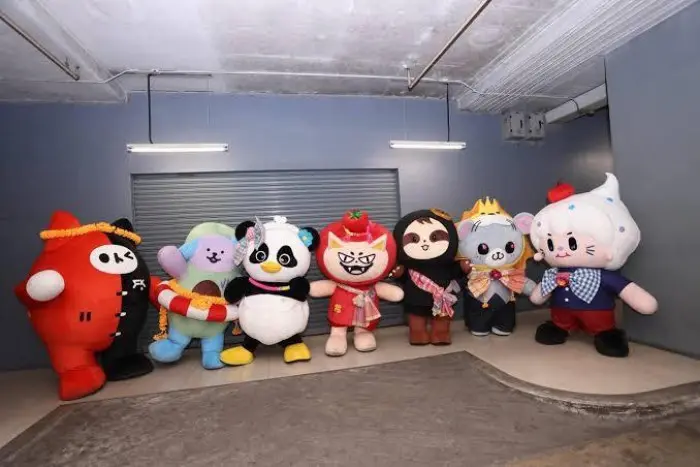
Polcasan captivates fans with his playfulness. In a video, despite his gibberish rapping, the youngest star earns a big cheer. He dispenses touches, hugs, and waves. When he bounces, shakes his butt, and caresses his belly, his movement arouses an irresistible urge to cuddle. He appears in a wide range of activities, from shows and fan meetings to advertisements. In only a year and a half, he has drawn a huge following, with over 222,000 followers on Instagram.
Polcasan is not a human being -- he is a bear-orca mascot.
Wearing a fluffy costume, the hybrid is recognisable by its striking colours. The white bear has the orca's triangular dorsal fin and a puffy fountain of breath. In 2024, Tawan Vihokratana (Tay) and Thitipoom Techaapaikhun (New), actors from GMMTV who are paired in Boys' Love (BL) productions, designed the still character for their fandom, called Polca. Early this year, they brought what they refer to as their baby to life.
Polcasan and his friends are the brainchild of GMMTV that is riding a mass obsession with cuteness.
In recent months, adorable characters, especially Butterbear, have caused a sensation. Labubu has taken over bags for girls and women. With its meteoric rise to fame, Moo Deng, a baby pygmy hippo, has been featured in international media outlets like the New York Times. An ever-expanding phenomenon, though concentrated in the US and Japan, has spawned global hits, like Hello Kitty, Pikachu, and Mickey Mouse.
When it comes to Polcasan and his friends, I shall regard them as the "gayby", a term some use for children with gay or lesbian parents, although male couples in BL do not identify themselves as gay.
Fascination with fluffy characters is more than regression to the utopia of innocent childhood, an infantile escapade from today's woes, and fulfillment of consumer desire, though it can be all these things.
Instead, cute mascots challenge the heteronormative media landscape by increasing the visibility of queerness and diverse forms of family.
Conceptually, cute and queer work towards disrupting hierarchical ways of thinking about identity. In his book The Power of Cute, Simon May, visiting professor of philosophy at King's College London, argues that cute is "a teasing expression of the uncertainty, the uncanniness, the continuous flux or becoming".
It is characterised by "unpindownability" in gender, species, and age. From my point of view, this goes with queer theory that, with its root as a joke, challenges the binary model of sex, gender, and sexual desire.
Gayby mascots are a hallmark of fluidity. In terms of gender, while some exhibit sex and gender markers, others are gender-neutral, androgynous, or indeterminate.
In terms of species, most of them are hybrids, but they are raised as human babies, who can speak and display anthropomorphic personalities, such as being playful, naughty, and cunning. In terms of the body, they are reconfigured as entities whose boundaries are porous.
Let's take a look at Polcasan. In the first draft, he had a tail, not two legs. Tawan drew the lower half of the character's body like Ariel in The Little Mermaid, who exchanges her tail for two legs. Polcasan is an example of those living with modified bodies. Consider Avocean, a character for the fandom of Jitaraphol Potiwihok (Jimmy) and Tawinan Anukoolprasert (Sea). An avocado-dog hybrid with a deformed ear is a multispecies creature in a differently abled body.
These cute characters not only unsettle dichotomies but also call into question the exclusive status of the human. By doing so, they undertake the post-humanist project -- a radical rethink of species uniqueness -- but in a playful way.
The creation of gayby mascots for two male idols, known as khu jin (imaginary couple), is part of staged homoeroticism. BL producers train handsome young men and pair them in series. When they switch off the fictional world, fans continue to revel in their camaraderie. Designed to fulfil the homoerotic fantasy, cuddly mascots are a commercial novelty that sustains the production of queer affect.
These characters can raise awareness about diverse forms of family. A basic unit of society is biologically tied to a union between a man and a woman. For gender-diverse couples, however, it is a matter of choice.
In Thailand, with the Marriage Equality Bill, they are allowed to adopt children. Efforts are also underway to legalise surrogacy. These characters help increase the visibility of queer families in a subtle manner.
Why does cuteness work? Citing a couple of cultural theorists, May explains that it cultivates "nurturing and self-giving instincts".
For example, Joshua Paul Dale said it is an "invitation to sociality" in the orbit of a loveable other. Gary Sherman and Jonathan Haidt view responses to cuteness as a moral expression of "concern for the welfare of others".
Mass obsession with cute is more than an escapade -- it affirms queerness without taking it seriously.
